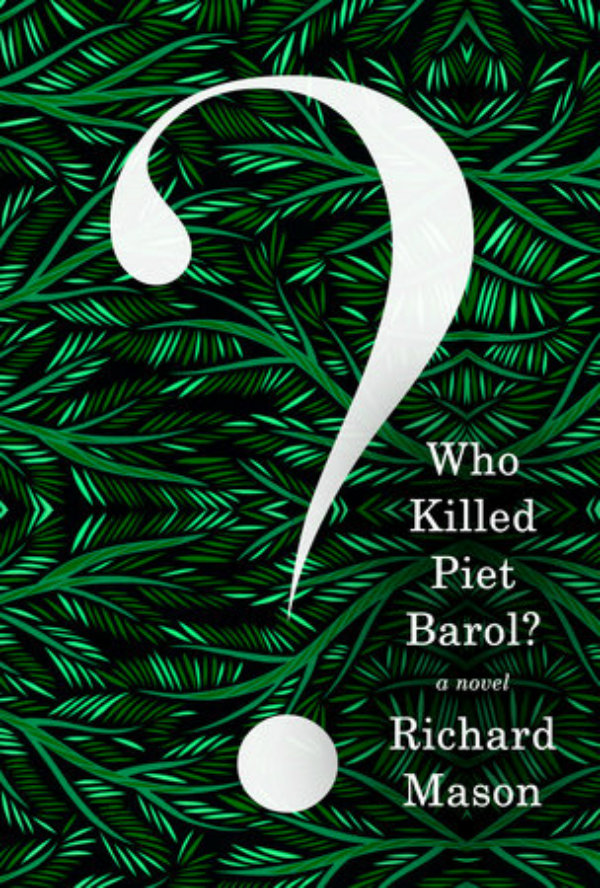‘Who Killed Piet Barol?’ by Richard Mason

Author: Walter Holland
March 15, 2017
Mason’s novel is a story of hidden identities and deception. It is also a story about two worlds and two vastly different modes of being. One is the “civilized” society of white colonial South Africa and the other is the mythological thinking of the native African Xhosa tribe. Set in 1914, the story recounts the tale of a Dutch man, Piet Barol, and his American wife, Stacey, who have established a furniture business in South Africa’s Cape Colony.
Readers may remember Piet fondly as the rake at the center of Mason’s 2012 novel, History of a Pleasure Seeker. In this follow up, we find Piet and Stacey posing as the Vicomte and Vicomtesse Pierre de Barol. The two embark on a scheme to obtain mahogany wood from the vast and forbidden interior of the country.
Having fallen on the verge of ruin, their money running out after years of decadent living, Piet pursues with audacity this plot to steal the bewitched trees of the Xhosa homeland. These ancient trees are known by the tribe to be the home for the spirits of its tribal ancestors.
In essence, Piet and his son Arthur, are exposed to and enthralled by the mystic knowledge of this tribe, and are drawn into its traditions as well as the native language of the village. Two, young Xhosa men, Ntsina Zini and Luvo Yako, guide them. Luvo, taught by German missionaries, speaks fluent Xhosa, English, German and Afrikaans, and acts as translator on the adventure. Both men have been promised a small fortune in cash for their efforts, a promise, which is uncertain to be kept.
Part anthropological study of folklore, part English Edwardian novel, part anthropomorphic fable, part Dickensian yarn, Who Killed Piet Barol takes on many ambitious themes. As with the English Edwardian novel, when authors of that period interested themselves in the disparity between the wealthy and the poor, explored and attacked social injustice, and vilified the selfishness of the upper classes, Mason ups the ante by investigating the beginnings of apartheid. Of course the Edwardian period was the height of European colonialism when issues of race and class were highly pronounced. Edwardians such as Kipling, Barrie, Wodehouse and others pushed back against the propriety and conservatism of the Victorian Age by showing distrust for political authority and challenging conventional values. There is also an undercurrent of homosexuality in Mason’s novel, most notably presented in the exchanges between Luvo and Ntsina, two native tribesmen
Luvo, the young Xhosa man, is the more complicated character; well-educated in the European tradition, a devout convert from his pagan beliefs to Christianity, and a conflicted homosexual driven by his natural urges, he exemplifies the perplexing fluidity of identity and its essential or learned behaviors, where stereotypical divisions are often blurred and challenged. This identity nonconformity is also captured by Piet and his son Arthur, who learn the Xhosan language and begin to embrace life in the wilderness. More contemporary questions of identity such as essentialism vs. constructivism, nature vs. nurture, biological sex vs. gender role are here at play. Indeed in the village of Gwadana, the chief witch doctor or “Sangoma” is a woman, Nosakhe Zini, grandmother to Ntsina.
Echoes of Rousseau hover in this book. A certain Romanticism is apparent as well. This Romanticism is found in Mason’s focus on his characters’ personal emotions, free play of the imagination, the exotic and mysterious natural setting of the story, and the uses of the symbolic and the supernatural. It is also represented in Piet’s mad pursuit to carve his phantasmagorical designs out of the ancestral wood, a quest, which places him in direct conflict with an animistic nature.
In a contrary fashion, harsh Realism attends the narrative, especially in the graphic description of the death of Ntsina’s bride, Bela, in the grip of an aged leopard, “[…] the blood flowed warm and fragrant. His left paw moved to her breasts. His claws sliced through this flesh, even softer than her rump. His prey was wriggling and screaming, heightening his ecstasy.”
And in the often, curious emphasis on biological processes which attends the narrative. Case in point, after Piet drinks a large amount of brandy, Mason writes: “But alcohol is drawn to water, and it raced through the expansive walls of his small intestine and into his bloodstream.” Also this physical realism is found in the description of the more carnal and sensate aspects of Piet and Stacey’s lovemaking:
He stayed hard for four hours and Stacey made full use of him. She did things with her tongue that flooded her husband’s head with endorphins. Sensual rapture made them whole after the anxieties of the last six months.
As well as Luvo’s obsessive desire for Ntsina:
Tonight he bent down and inhaled at the nape of his friend’s neck, and was met by a scent that made every part of him feel grateful to be alive. His erection was instantaneous and solid as a tree root. But what was entrancing about Ntsina’s smell was not only the muskiness of a strong man who has had a day of intense exertion, but a vulnerability, a gentleness, that made Luvo feel light-headed.
As World War I rages a vast distance away and “civil” society and the old order self-destruct, so the “natural” world of the forest and the Xhosa homeland goes through its own turmoil. Indeed it is ironic that in many ways the native South African culture is rooted in a natural wisdom more rational and fairer than its self-called “civil” twin.
All told, this is an engaging novel that spins a fantastical tale. Its imaginative scope is broad. It succeeds at being colonial literature written from a post-colonial viewpoint.
Who Killed Piet Barol?
By Richard Mason
Knopf
Paperback, 9780385352888, 384 pp.
January 2017

